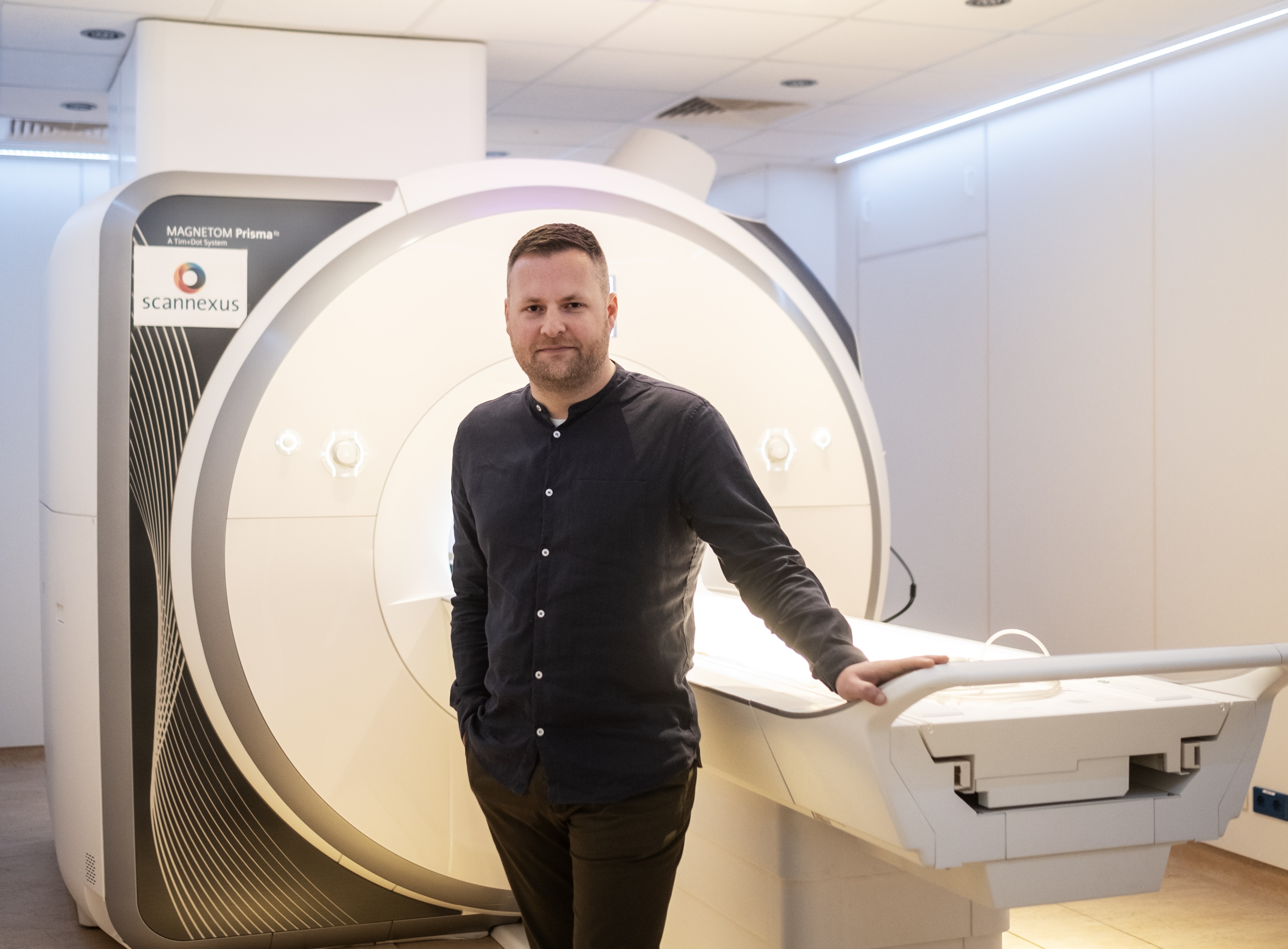Gaining insight into motivation: the driving force behind all our behavior
Neuroscientist Dennis Hernaus investigates the reward system in our brain. How does this ‘brain network’ ensure that we become motivated? That we pursue goals and can learn about reward and punishment? Hernaus finds motivation as a research field enormously interesting: “Motivation is the driving force behind all our behavior. Yet we know so little about it.” Hernaus conducts research on dopamine, which most people know as the reward substance. Wrongly, says Hernaus: “You should see dopamine as a highlighter that teaches us which situations are important.”
About motivation
Dennis Hernaus: “Motivation is an essential part of our daily lives. It’s about ‘drive’ – the will to earn a reward or avoid punishment. I notice that when people talk about motivation, they often think of big things in life. For example, obtaining a diploma or getting a promotion at work. But motivation – when it’s functioning ‘normally’ – is actually present in all sorts of smaller things. Getting up from your couch to cook a meal. Working harder so you don’t get in trouble with your boss. From an evolutionary perspective, motivation is vital. That’s why it’s so important to find out how motivation can become disrupted, especially considering it is a common transdiagnostic issue1. For instance, people with depression, psychosis, or anxiety disorders can completely lose interest in things they once intensely enjoyed. How can this happen? In my research, I try to understand exactly what goes wrong in the brain when this occurs.
But this is not always easy. The concept of 'motivation' can be seen as a collection of various cognitive processes that all need to function properly. To ‘want’ something, you need to be able to do quite a bit: you must be able to learn, make judgments (about what is and isn't worthwhile), and translate those judgments into a plan and action. A single error in this complex chain of processes can lead to disruptions in motivation. What also makes the research challenging is that disruptions in motivation do not always manifest in the same way. In some mental disorders, people lose interest, but in other cases (such as with anxiety disorders), people are willing to put in a lot of time and effort to avoid their greatest – unrealistic – fears. Additionally, disrupted motivation is interesting from a philosophical perspective: if people are not motivated, normal behavior is absent. But how do you measure the absence of behavior? All these aspects make fundamental and clinical research into motivation extremely challenging and, for me, extra fascinating.”

Dennis Hernaus (1987) obtained his PhD from Maastricht University in 2014 on the role of the dopamine system in stress processing. After research training at King’s College London and postdoctoral research at the University of Maryland, he returned to Maastricht in 2018. Here, as an assistant professor, he continues his research on the interaction between dopamine, stress, and motivation at the Mental Health and Neuroscience Research Institute (MHeNS).
Dopamine and the reward system
Hernaus researches the role of dopamine and the reward system in our brains. Hernaus: “Dopamine is a kind of 'messenger substance' that facilitates communication between brain cells. Many people associate dopamine with satisfaction, enjoyment, and pleasure. Although there is a clear link between dopamine and reward, in recent years we have learned that dopamine is fundamentally not a reward substance. What’s remarkable about dopamine is that it is released when something unexpected happens. If you don’t expect a reward but suddenly receive one (and vice versa), the activation of those dopamine cells changes abruptly. It therefore is better to see dopamine as a highlighter that marks what deserves our attention. We also now know that the amount of dopamine released by brain cells signals whether and which goals are worth pursuing.”
Do you also look at other substances besides dopamine?
“To understand how motivation arises, we also look at how the reward system interacts with other systems in our body. For instance, we have researched the role of stress hormones. When we are stressed, our kidneys release cortisol and adrenaline. Since we know that frequent stress is a risk factor for mental disorders, we recently studied how cortisol and adrenaline affect the reward system. In this research, we see that these stress hormones can cause a change in motivation. People become less interested in obtaining rewards but are more strongly motivated to avoid punishment. You could say that the reward system adjusts our ‘motivation state’ to the situation. When someone is under stress, avoiding danger is paramount. From an evolutionary perspective, this is a smart adaptation. But if someone is constantly under stress and their reward system is only set to avoid negative experiences and no longer to obtain positive stimuli, you can understand how this can lead to depression or anxiety disorders.”
If you expect a reward, but you don't receive it, something happens with those dopamine cells.
Research
“In my research on motivation, I use a combination of imaging, medication, and computer tasks. As an imaging technique, we use an MRI scanner to map the activity of the reward system. We do this while people perform computer tasks that measure various subcomponents of motivation. For example, we use interactive apps to measure how people learn about rewards and punishments and how they choose to invest energy to achieve goals – such as squeezing a handgrip dynamometer. To investigate the causal role of the reward system, we often use medications. By giving people a substance in pill form that affects the reward system, we can measure how they perform on motivation-related computer tasks. The research is placebo-controlled: we look at differences between people with and without the pill and include individuals across the spectrum, from patients to healthy people. Nearly equally we want to understand how motivation works when it functions 'normally'.”
How far along are you?
“For several years, we have been developing a kind of 'test battery', a group of computer tasks that can identify and pinpoint specific disruptions in motivation. Given that motivation research is a complex and challenging field, we collaborate multidisciplinary with colleagues both domestically and internationally, with other universities, as well as mental health institutions and companies. Together, we are trying to develop a set of complementary tasks to definitively determine: 'this person’s motivation is disrupted here and not there’. You can imagine that one type of disruption requires a very different intervention than another. People who have trouble translating their intention into action need something different than those who have trouble learning. With this new measurement tool, we can pinpoint where in the chain things go wrong.”
There is still much to do. If we look five years ahead, what will you have found by then?
“One of the things I want to understand is how motivation is dynamically adjusted. In daily life, you constantly have to decide whether it’s worthwhile to pursue a certain goal. I want to find out which brain systems ensure that we continuously adjust our motivation depending on the opportunities that arise. Which substances in the brain are responsible for this dynamic regulation of motivation? I believe the key lies in recognizing that motivation is dynamic. This could also explain why motivation sometimes fails only for certain goals. That doesn’t automatically mean the whole system is broken. Someone might be able to be social with others but not motivated to work. Even when looking at people with mental health issues: there are moments when they are motivated. Something must go wrong in the regulation of motivation, and that should be explainable.”
Application and impact
Why is it important to understand how it works? What is its impact on society?
“From my research perspective, we want to understand how motivation can become disrupted. Previously, we thought this only applied to people with depression, but nearly all mental disorders are accompanied by changes in motivation. My personal goal is to understand the points of intervention for treating these problems. If we know how to restore the dynamics of motivation, the impact will be that it also makes the treatment of other issues easier.
"The field I am in is primarily fundamental and mechanistic, but we also look at its translatability to the clinic. With the test battery, which we are developing in collaboration with Mondriaan and MUMC+, we are creating reward tasks that we can standardize for clinical practice to differentiate between people with motivational problems, such as those with depression and psychosis. Based on the individual motivation profile, you can make predictions about how people will respond to a certain treatment. We have made significant progress, but the research still needs a few more years before we have well-validated tasks that can be used by a clinician to map someone's motivation profile easily.
If we find ways to improve motivation, it will greatly help in the treatment of other associated issues. And if we can identify the mechanisms by which motivation becomes disrupted, this can eventually aid in early detection: as a warning signal for increased risk of depression-like symptoms, for example. By combining all our expertise, we will eventually solve the motivation puzzle.”
Nearly all mental disorders are accompanied by changes in motivation.
1A transdiagnostic perspective means that one and the same underlying mechanism can lead to a number of disorders or conditions.
Text: Eline Dekker
Photo: Joey Roberts
Also read
-
In the upcoming months, we’ll share tips on Instagram for our students on how to live a healthier life. Not just a random collection, but tips based on actual research happening at our faculty. The brains behind this idea are Lieve Vonken and Gido Metz, PhD candidates at CAPHRI, the Care and Public...
-
Ageing well isn’t just about physique. It also means being aware of a healthy brain. To prevent dementia, Martin van Boxtel and his colleagues from ‘Alzheimer Centrum Limburg’ founded the Maastricht Ageing Study (MAAS) 30 years ago. MAAS kept track of 2043 people over 25 years in a longitudinal...
-
Can urine be used to detect renal cell carcinoma? The current approach in the case of small renal masses is in most cases a precautionary partial or complete removal of the kidney, without knowing whether the mass is benign or malignant. Molecular epidemiologist Kim Smits is working at MUMC+ on a...


